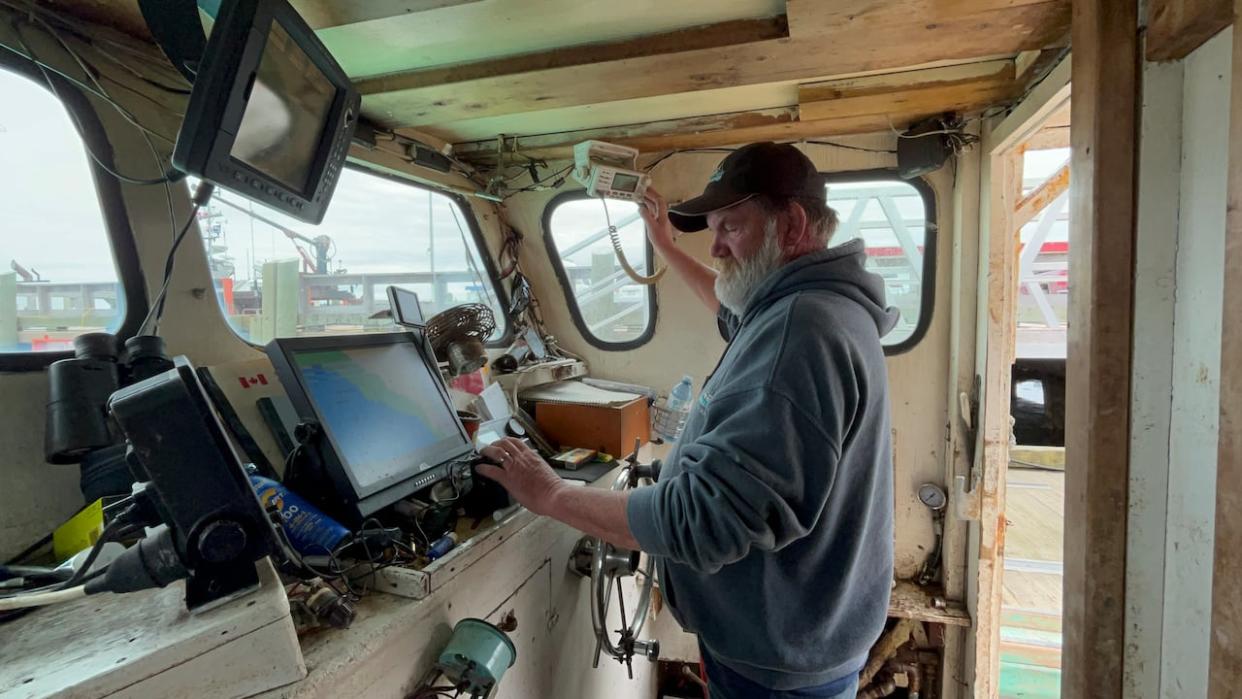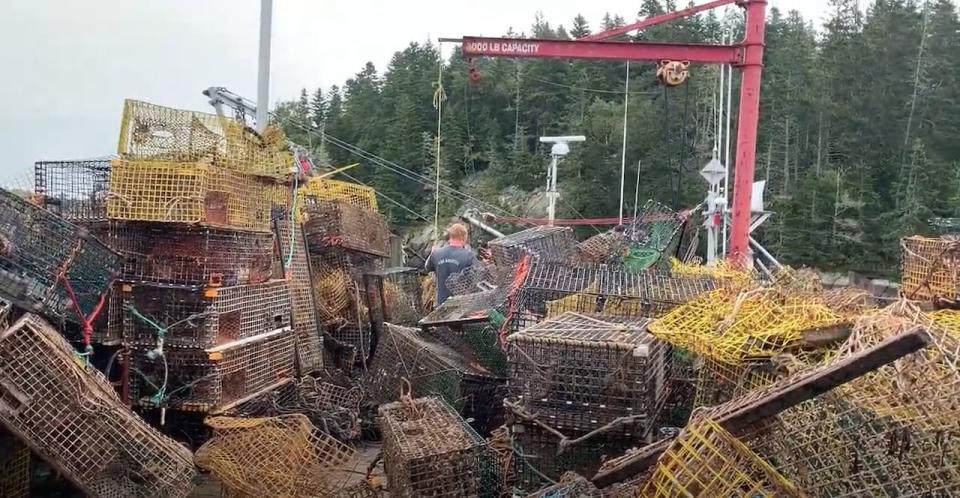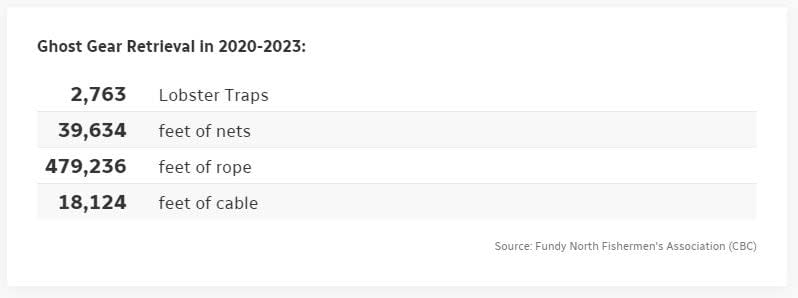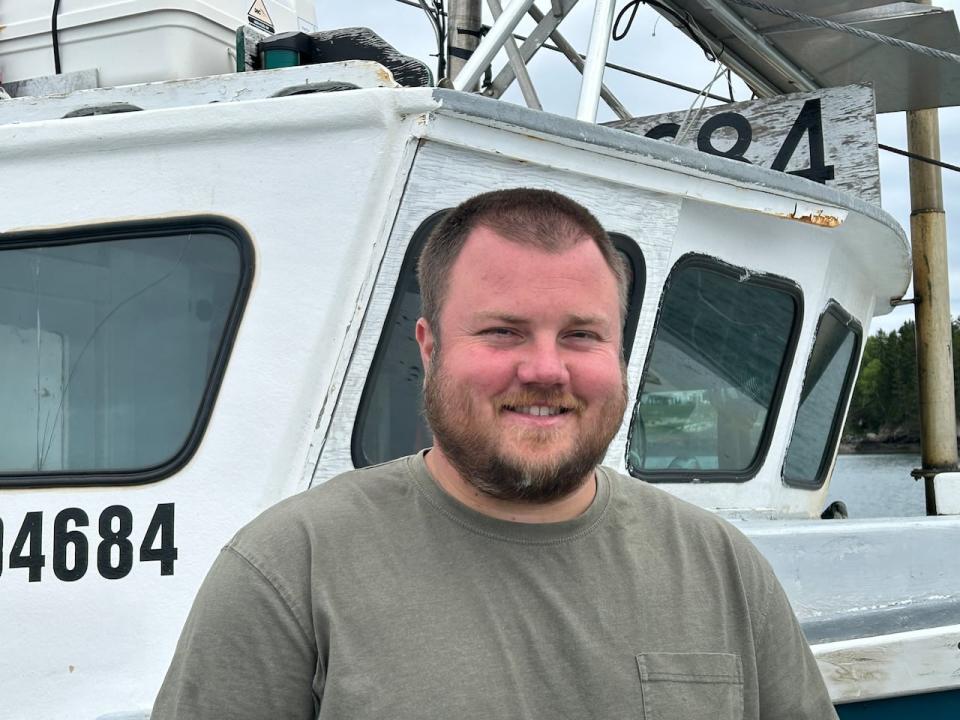Fishermen cleaning up huge snarls of ghost gear in Bay of Fundy want funding to continue

In the cabin of his fishing boat near Saint Andrews, Greg Beckerton points to a radar screen to show the spots where he has lost traps and other fishing gear.
After more than three decades on the water, he knows how easy it is to lose gear, and how important it is to remove what is known as "ghost gear" from the Bay of Fundy.
Beckerton is a member of the Fundy North Fishermen's Association and has volunteered to help on many of the 137 ghost gear retrieval operations in the past year.
"I'm quite amazed at how much is there," he said of the thousands of traps, buoys and nets he has helped to pull up.
"When somebody tries to fish there, those traps are competing with the actual fishing traps ... and of course that marine life, once it gets in it, it can't get out, then it's just there. And then it'll just keep fishing forever and ever."
The ghost gear also creates a risk to larger species in the ocean, including the endangered North Atlantic right whale.

The usable traps are returned to their tagged owners while all the unusable trash is sent to recycling, says fisherman Khalin Brown. (Courtesy of Fundy North Fishermen's Association)
Darlene Norman-Brown, assistant director of the Fundy North Fishermen's Association, said the group has been able to clean up a lot of ghost gear since 2008, thanks to federal funding.
But she says Fisheries and Oceans Canada has ended its support — something she believes is a mistake.
"We've just scratched the surface," Norman-Brown said of the amount of gear still on the bottom.
Some of the snarls are so large that fishermen have named them. She said the Cod Hole snarl is reported to be "the size of a small house." A fisher once lifted it to the surface, but the ropes couldn't hold its massive weight, Norman-Brown said.
WATCH | 'Anything you could think of, they find out there':
The latest funding, from 2022-2024, was targeted toward combing the waters off Atlantic Canada and Quebec after a lot of gear was lost as a result of Hurricane Fiona.
Norman-Brown said since 2020, DFO funding has helped them retrieve more than 2,500 lobster traps, about 12 kilometres of nets and about six kilometres of cable.
These retrieval operations also helped them rid the ocean of 146 kilometres of rope — almost the distance between Moncton and Miramichi.

Darlene Norman-Brown, assistant director of the Fundy North Fishermen's Association, says their current ghost gear retrieval numbers are just scratching the surface of what's in the ocean. (Rhythm Rathi/CBC)
Fisheries and Oceans Canada did not answer questions from CBC about whether the funding for ghost gear retrieval will be restored.
In an emailed statement, spokesperson Axel Rioux said "more details on the next steps will be shared in the coming weeks."
Rioux said $58 million was spent by the department on ghost gear retrieval projects in Canada and internationally between 2020 and 2024.
Ghost gear snarls gather large mix of debris
The Fundy North Fishermen's Association has focused its cleanup operations on Passamaquoddy Bay, the Head Harbour Passage around Campobello Island, and the Deer Island area which have some of the highest concentrations of ghost gear.
With tides and currents, Norman-Brown said the gear often gets "drug off and hauled down," which creates a tumbleweed effect.
Those snarls gather everything in their path. Volunteers have pulled up everything from a 3,600-kilogram (8,000-pound) anchor to the front end of a 1940s truck.

The two biggest snarls identified by the Fundy North Fishermen's Association are the Spruce Island snarl and the Cod Hole snarl, which is said to be the size of a small house. (News Graphics/CBC)
"They bring up hoodies, they bring up tires, they bring up car engines," she said.
"Anything you could think of, they find out there."
For their work, the Fundy North Fishermen's Association will receive the Gulf of Maine Council industry award June 11.
Risky work
Norman-Brown said they want to spread awareness and secure funding to buy the equipment needed to detect and recover the piles of gear more efficiently.
Beckerton said the work is dangerous because the grapples they use are heavy and "it doesn't take a whole lot of wave action" for them to sway close to your head.
He said sometimes it becomes essential to let go of a heavy snarl, and crew members have to be vigilant to avoid getting caught in the ropes.
Some snarls are so heavy that the rope snaps or the crew has to call for assistance because two or three vessels are required to lift them. It's also impossible to know what's going to come out of the water.

Between 2020 and 2024, the Fundy North Fishermen's Association also retrieved several other items including hoodies, tires, car engines and concrete blocks from the ocean. (News Graphics/CBC)
"I caught up a fender pile off of a wharf and it came up and hit the actual bottom of the boat," Beckerton said.
Fortunately the crew was hauling slowly enough that it just bumped the bottom.
"If you'd been hauling hard enough, you might have been able to put that through the boat and that would make quite a hole for the water to come in."
He said not every item they find was lost recently. Last summer, Beckerton dragged up a wooden trap with a tag from 1992. He said it was in rough shape and his young crew couldn't tell what it was.
"It was older than most of my deckhands," he said with a laugh.

Khalin Brown has lost gear to storms before and he says losing equipment is expensive. (Rhythm Rathi/CBC)
Khalin Brown also volunteers to retrieve ghost gear, and said besides the environmental harm it does, it is also expensive for fishermen to lose gear.
"Every trap we lose, you're talking $250 to $350 a piece, plus rope and buoys."
After every operation, the usable traps are returned to their tagged owners and all the unusable trash is recycled.
"If we had more technology and funding to do it, the side-scan sonar would help us locate and find missing gear," he said.
Norman-Brown agrees, and is hopeful Ottawa will come through with continued funding to clean up the Bay of Fundy.
"The longer time passes without this work being done, then the more ghost gear is being created ... and as long as that gear is on the bottom, it's a hazard to the marine life, it's a hazard to the fisherman's way of life and it's a hazard to humans in general because of the microplastics."

 Yahoo News
Yahoo News 
